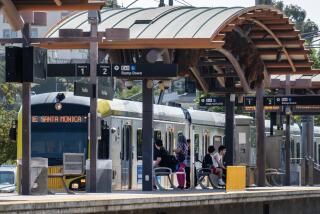Court oversight of buses lifted
Saying that Los Angeles County transit officials have âsubstantially compliedâ with their promise to improve bus service for poor and minority riders, a federal judge Wednesday ended a decade of court oversight of the nationâs third-largest public transportation system.
The Metropolitan Transportation Authority has been required to spend more than $1 billion to buy buses, add service and maintain low fares since 1996, when the agency entered into a consent decree to settle a civil rights lawsuit with bus riders.
âAs a result of the consent decree and the efforts of all the parties involved, the quality of life has improved for Los Angelesâ public transit dependent poor population,â Senior U.S. District Court Judge Terry J. Hatter Jr. wrote in his three-page order.
The consent decree, which expires Sunday, âhas served its purpose and will not be extended,â Hatter wrote.
While transit officials pledged Wednesday to maintain the improved service, advocates for bus riders said they would monitor the agency for any cuts in countywide operations. They had sought to extend the decree until the agency was in full compliance.
âIf MTA significantly guts its bus system, we will be back before Judge Hatter asking for an extension,â said E. Richard Larson, an attorney for the NAACP Legal Defense and Educational Fund, which represented bus riders. âWe are not going away.â
Larson and others fear that, without the courtâs watchful eye, transit officials will return to neglecting the countyâs heavily used bus system to build and operate expensive subway and light-rail lines through more affluent neighborhoods.
Still, bus riders have benefited from the consent decree. âOvercrowding is still excessive,â said attorney Connie Rice, who also represents bus riders. âItâs better than it was 10 years ago.â
Under the consent decree, the MTA reluctantly purchased 1,472 natural gas-powered buses, added 1.3 million hours of service and increased security while maintaining low fares.
Those actions transformed the countyâs transportation system -- once plagued by inoperable buses and frequent breakdowns, a lack of drivers, poor adherence to schedules and insufficient capacity -- into a nationally recognized transit leader.
This month, the MTA -- whose 2,000-bus fleet went from being one of the nationâs oldest and dirtiest to one of its newest and cleanest -- was ranked among the nationâs best transit agencies by its trade group, the American Public Transportation Assn.
County Supervisor Gloria Molina, who chairs the MTA board, assured riders, in a written statement, that the transit agency, now also known as Metro, âis committed to sustaining the improvements made to the bus system.â
âWeâre not about to lower our standards,â she said. âNobody at Metro wants to turn back the clock and undo all the progress we have made.â
In an interview, Molina said the MTA board -- which is dominated by the five county supervisors, the mayor of Los Angeles and his three appointees -- may have to restructure some bus service to make the transit system operate more efficiently. But she contends that service levels would remain comparable.
County Supervisor Zev Yaroslavsky predicted the agency would stay âfaithful to the principles that the customer comes first.â
But he added that the bus routes should be decided by transit officials -- not lawyers.
Because of the consent decree, some routes with few riders have been allowed to remain because transit officials had been unwilling to fight in court with bus rider advocates over every change, he said.
Without court supervision, the transit agency âwill have more local control and flexibility in allocating resourcesâ to buses, bike programs, carpool and other highway projects, Molina said.
The agency also will be able to reroute buses to eliminate duplication created by rail service and municipal bus operators, such as Santa Monicaâs Big Blue Bus, and better serve some outlying areas of the county, said Roger Snoble, the agencyâs chief executive for five years.
In court last week, Larson argued that the consent decree should be extended because Metro has failed to adequately reduce overcrowding on many of its busiest buses.
Under the consent decree, no more than nine passengers, on average, may be standing on a 42-seat bus during any 20-minute peak period. But the sides could never agree how to measure compliance.
In denying the bus ridersâ request, Hatter conceded that the original agreement âwas a less than perfect document.â
âAs a result, it is impossible to achieve absolute compliance,â he wrote. âHowever, it is possible for MTA to substantially comply with the consent decree.â
And he found that the agency had. âDespite increasing ridership, increasing traffic congestion and fiscal constraints, the MTA has substantially complied with the consent decree while maintaining fares at reasonable levels,â Hatter wrote.
But Hatter retained jurisdiction over the agencyâs new service implementation plan, established to better serve the countyâs job, education and health centers, until Nov. 30, 2010.
The judge has supervised county transit services since 1996, two years after bus rider advocates sued the MTA.
But changes did not come fast or easy.
Transit officials, who voluntarily entered into the decree to avoid a jury trial, fought most of the courtâs orders. When Hatter ordered transit officials to buy 248 more buses, the agency spent three years and millions of dollars trying to overturn his ruling. They lost in every court.
On Wednesday, after a decade of bitter litigation, transit officials finally won a courtroom victory.
âI think all of our customers are big winners here,â Snoble said.
More to Read
Sign up for Essential California
The most important California stories and recommendations in your inbox every morning.
You may occasionally receive promotional content from the Los Angeles Times.










